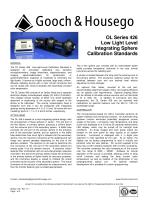 Website:
Gooch & Housego
Website:
Gooch & Housego
Group: Gooch & Housego
Catalog excerpts

OL Series 426 Low Light Level lntegrating Sphere Calibration Standards GENERAL The OL Series 426 Low-Light-Level Calibration Standard is designed for accurately calibrating very sensitive microphotometers, image intensifiers, telephotometers, and imaging spectroradiometers for photometric or spectroradiometric response at moderate to extremely low light levels. It serves as a highly accurate, large area, uniform, diffusely radiating source with a near normal luminance that can be varied over nearly 6 decades with essentially constant color temperature. The OL Series 426 consists of an Optics Head and a separate electronic display console/power supply (OL 400-C Controller). This enables remote location of either unit, which facilitates alignment or positioning of the source with respect to the device to be calibrated. The source module/optics head is designed such that it can be configured with integrating spheres having diameters of 4, 6, 8, 12 and 18 inches with exit (radiating) ports of 1, 1½, 2, 3 and 6 inches, respectively. OPTICS HEAD The OL 426 is based on a dual integrating sphere design, with the arrangement of these spheres in series. The exit port of the first sphere, or primary sphere, produces a uniform beam into the entrance port of the secondary sphere. A baffle tube connects the exit port of the primary sphere to the entrance port of the secondary sphere, and an aperture in the baffle tube determines how much light is allowed into the secondary sphere, thus the maximum luminance at the radiating port can range over several decades depending on the size of the aperture installed. The aperture is not used to determine the true luminance at the exit port of the secondary sphere but merely scale it by the desired amount. A precision silicon detector-filter combination with an accurate photopic response mounted in the wall of the primary sphere tracks the luminance in the primary sphere at higher levels for accuracy purposes, and the luminance display is scaled to indicate the actual luminance at the exit port of the secondary sphere. The actual luminance of the exit port is calibrated via measurements, and then the monitor detector gain is scaled appropriately. Contact: orlandosales@goochandhousego.com The in-line sphere port concept with an intermediate spider baffle provides exceptional uniformity in the near normal luminance across the radiating port. A shutter is located between the lamp and the entrance port of the primary sphere. The luminance/ radiance output can be switched between zero and any desired level without adjustment or lamp changes. An optional filter holder, mounted at the exit port, accommodates alignment targets, filters, de-coupling diffusers etc. for specific user requirements. Spectral shaping filters can be utilized to simulate various sources such as Illuminate A, B, C, D65, etc. In addition to luminance and color temperature, the OL Series 426 can be obtained with calibrations for spectral radiance over the 350 to 1100 nm wavelength range. CONTROLLER The microprocessor-based OL 400-C Controller performs all system interface and monitoring functions. An automatic ramp up/down function eliminates potentially dangerous current surges to the lamp. Luminance, color temperature, and lamp current are displayed on a 2 line by 20 character alphanumeric LED display, which may be turned off for low-light level conditions. An 8-key keypad and main power switch are located on the front panel for easy access to all system functions. Luminance is displayed with 4 ½ digits plus exponent in units specified by the user. As an option, the display can be factory programmed to read in virtually any pertinent units the user desires. DC current supplied to the lamp has a 0.001 ampere resolution with a 0.02% uncertainty. The controller computes the color temperature of the source over the range of 2000 – 3000K. Software for remote operation of the source is provided, allowing control of lamp on/off functions and setting the lamp current (color temperature) as well as readout of the photometer in any preprogrammed optical unit. An optional software development kit is available for custom programming. As part of our policy of continuous product improvement, we reserve the right to change specifications at any time Bulletin 136 / Rev 7-11 Page 1 of 2
Open the catalog to page 1
LUMINANCE LEVELS (nominal) Maximum Luminance Model Number Sphere Diameter Exit Port Diameter Other configurations available upon request. Contact: orlandosales@goochandhousego.com As part of our policy of continuous product improvement, we reserve the right to change specifications at any time Bulletin 136 / Rev 7-11 Page 2 of 2
Open the catalog to page 2All Gooch & Housego catalogs and technical brochures
-
410 Precision Lamp Source
2 Pages
-
15AB LED Receptor
2 Pages
-
IMPACT series
2 Pages
-
LightGate Series
5 Pages
-
TX series
2 Pages
-
2011 Product Line Catalog
103 Pages
Archived catalogs
-
Automated spectroradiometric
8 Pages
-
Programmable DSP Radiometer
2 Pages






























